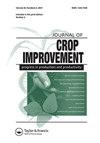茄子(Solanum melongena L.) var. Mattu Gulla的高效体细胞胚胎发生和植株再生
IF 1.5
Q3 AGRONOMY
引用次数: 0
摘要
摘要建立了一种独特的茄子品种“Mattu Gulla”的器官发生方案,该品种具有独特的大小,颜色和风味。本研究的目的是建立一个可靠和有效的方案的起始和成熟的体细胞胚胎成植物。外植体在添加2,4-二氯苯氧乙酸(2,4- d) (1.0 mg/L)和苄基氨基嘌呤(BAP) (1.5 mg/L)的Murashige和Skoog培养基上培养愈伤组织。将发育中的愈伤组织(45天)转移到添加了植物生长调节剂的MS培养基上,测定外植体的胚性。吲哚丁酸(IBA) (1.5 mg/L)和吲哚丁酸(BAP) (1.0 mg/L) (2,4- d和噻唑脲(TDZ) (1.0 mg/L)处理下胚轴愈伤组织的胚性愈伤组织比例高于子叶和叶愈伤组织。用2,4- d和TDZ (1.0 mg/L)组合进行传代培养后第23天,记录胚萌发情况。以子叶愈伤组织发育成体细胞胚的植株数量最多,离体成活率显著。而下胚轴愈伤组织的胚和离体成活率最低。在温室条件下,驯化后的幼苗茁壮成长,并产生具有活籽的果实。本研究建立的方案可作为大规模体细胞胚胎发生和植株微繁的平台。体细胞胚胎操作应作为一种生物技术工具,在作物育种和改善所需的农艺性状。本文章由计算机程序翻译,如有差异,请以英文原文为准。
High-efficiency somatic embryogenesis and plant regeneration in brinjal (Solanum melongena L.) var. Mattu Gulla
ABSTRACT The organogenesis protocol was established for a unique brinjal (Solanum melongena L.) variety, “Mattu Gulla”, which has a distinct size, color and flavor. The objective of this study was to develop a reliable and efficient protocol for the initiation and maturation of somatic embryos into plantlets. The explants were cultured on Murashige and Skoog medium augmented with 2,4-dichlorophenoxyacetic acid (2,4-D) (1.0 mg/L) and benzyl aminopurine (BAP) (1.5 mg/L) for callus initiation. The developing calli (45-days old) were transferred onto an MS medium augmented with plant growth regulators to determine the embryogenic potential of the explants. The proportion of embryogenic callus was higher in hypocotyl-derived calli (HC) with indole butyric acid (IBA) (1.5 mg/L) and BAP (1.0 mg/L with 2,4-D and thidiazuron (TDZ) (1.0 mg/L) than in cotyledon and leaf-derived calli. The embryo initiation was recorded on the 23rd day after subculture from HC with the 2,4-D and TDZ (1.0 mg/L) combination, and germination was recorded. The somatic embryos developed from cotyledon-derived calli showed the highest number of plantlets and a significant percentage of ex vitro survival. In contrast, the lowest number of plantlets was noted from the embryos of hypocotyl-derived calli and ex vitro survival of plantlets. Under greenhouse conditions, the acclimatized plantlets thrived and produced fruits with viable seeds. The established protocol in this study should serve as a platform for large-scale somatic embryogenesis and micropropagation of plantlets. The somatic embryo-based manipulation should be exploited as a biotechnological tool in crop breeding and improving desired agronomic traits.
求助全文
通过发布文献求助,成功后即可免费获取论文全文。
去求助
来源期刊

Journal of Crop Improvement
Multiple-
CiteScore
3.30
自引率
7.70%
发文量
42
期刊介绍:
Journal of Crop Science and Biotechnology (JCSB) is a peer-reviewed international journal published four times a year. JCSB publishes novel and advanced original research articles on topics related to the production science of field crops and resource plants, including cropping systems, sustainable agriculture, environmental change, post-harvest management, biodiversity, crop improvement, and recent advances in physiology and molecular biology. Also covered are related subjects in a wide range of sciences such as the ecological and physiological aspects of crop production and genetic, breeding, and biotechnological approaches for crop improvement.
 求助内容:
求助内容: 应助结果提醒方式:
应助结果提醒方式:


